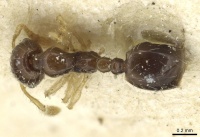Monomorium strangulatum
| Monomorium strangulatum | |
|---|---|

| |
| Scientific classification | |
| Kingdom: | Animalia |
| Phylum: | Arthropoda |
| Class: | Insecta |
| Order: | Hymenoptera |
| Family: | Formicidae |
| Subfamily: | Myrmicinae |
| Tribe: | Solenopsidini |
| Genus: | Monomorium |
| Species: | M. strangulatum |
| Binomial name | |
| Monomorium strangulatum Santschi, 1921 | |
Collected in mesic-forest litter sampling and vegetation beating.
Identification
Bolton (1987) - A member of the M. strangulatum complex in the M. monomorium species group.Despite its 11-segmented antennae the closest relatives of strangulatum are the 12-segmented Monomorium draxocum, Monomorium noxitum and Monomorium gabrielense.
Keys including this Species
Distribution
Latitudinal Distribution Pattern
Latitudinal Range: -2.226388889° to -2.283333333°.
| North Temperate |
North Subtropical |
Tropical | South Subtropical |
South Temperate |
- Source: AntMaps
Distribution based on Regional Taxon Lists
Afrotropical Region: Central African Republic, Democratic Republic of Congo, Gabon, Uganda, United Republic of Tanzania.
Distribution based on AntMaps
Distribution based on AntWeb specimens
Check data from AntWeb
Countries Occupied
| Number of countries occupied by this species based on AntWiki Regional Taxon Lists. In general, fewer countries occupied indicates a narrower range, while more countries indicates a more widespread species. |

|
Estimated Abundance
| Relative abundance based on number of AntMaps records per species (this species within the purple bar). Fewer records (to the left) indicates a less abundant/encountered species while more records (to the right) indicates more abundant/encountered species. |

|
Biology
Castes
Nomenclature
The following information is derived from Barry Bolton's Online Catalogue of the Ants of the World.
- strangulatum. Monomorium strangulatum Santschi, 1921c: 121, fig. 3 (w.) TANZANIA.
- Type-material: lectotype worker (by designation of Bolton, 1987: 413).
- Type-locality: Tanzania (“Afrique orientale allemande”): Bezirk-Bukoba, Buk. 26 (Viehmeyer).
- Type-depository: NHMB.
- Status as species: Ettershank, 1966: 92; Bolton, 1987: 413 (redescription); Bolton, 1995b: 267.
- Distribution: Central African Republic, Democratic Republic of Congo, Gabon, Tanzania, Uganda.
Unless otherwise noted the text for the remainder of this section is reported from the publication that includes the original description.
Description
Worker
Bolton (1987) - TL 1.8-2.0, HL 0.41-0.46, HW 0.33-0.38, CI 78-83, SL 0.32-0.38, SI 95-102, PW 0.20-0.26, AL 0.48-0.58 (10 measured).
Clypeal carinae sharply developed, widely separated and feebly divergent anteriorly, the carinae running to the anterior margin at the angle separating the anterior and lateral margins of the projecting median portion of the clypeus. Space between the clypeal carinae very shallowly transversely concave. Maximum diameter of eye 0.22-0.26 x HW and with 5 ommatidia in the longest row. In full-face view the posterior margins of the eyes at the midlength of the sides. Antennae with 11 segments and the scapes, when laid straight back from their insertions, surpassing the occipital margin. Sides of head behind eyes convex in full-face view, converging posteriorly and meeting the occipital margin through a broad continuous curve on each side, so that the transverse median portion of the occipital margin appears very short. Promesonotum domed-convex in profile, on a much higher level than the propodeum. Mesonotum forming a convex slope posteriorly to the very broadly but shallowly impressed metanotal groove, the latter with conspicuous strong cross-ribs. Propodeum behind the metanotal groove convex and sloping posteriorly, joining the declivity through a broad curve. Propodeal spiracle large, dominating the side of the sclerite. Petiole with an elongate but stout anterior peduncle which is subtended by an inconspicuous ventral process in the form of a narrow cuticular strip. Petiole node large, high and subconical, narrowly rounded above. Node of postpetiole anteroposteriorly compressed, narrow in profile, with a steeply sloping anterior face; All dorsal surfaces of head and body with numerous standing hairs, the scapes with long suberect to subdecumbent pubescence which is almost as long as the maximum width of the scape. Head and body unsculptured except for hair-pits, metanotal cross-ribs and extensive reticulate-punctate to reticulate-granulate sculpture on the mesopleuron. Head and body dark brown, the appendages yellow and contrasting strongly with the body colour.
Type Material
Bolton (1987) - Lectotype worker, Tanzania: Bukoba, Bezirk, Buk. 26 (Viehmeyer) (Naturhistorisches Museum, Basel) (here designated) [examined].
Note. The two worker syntypes originally mounted on a single pin and constituting the type-series of strangulatum belong to two separate species. The upper specimen, which fits Santschi's original description the best, is here designated as the lectotype of strangulatum, and has 11 antennal segments. The lower specimen has been removed to a separate pin and now constitutes the holotype of Monomorium disoriente; this species has 12 antennal segments.
References
- Bolton, B. 1987. A review of the Solenopsis genus-group and revision of Afrotropical Monomorium Mayr (Hymenoptera: Formicidae). Bulletin of the British Museum (Natural History). Entomology. 54: 263-452.. (page 413, see also)
- Santschi, F. 1921c. Quelques nouveaux Formicides africains. Annales de la Société Entomologique de Belgique 61: 113-122 (doi:10.5281/ZENODO.14442) (page 121, fig. 3 worker described)
References based on Global Ant Biodiversity Informatics
- Bolton B. 1987. A review of the Solenopsis genus-group and revision of Afrotropical Monomorium Mayr (Hymenoptera: Formicidae). Bulletin of the British Museum (Natural History). Entomology 54: 263-452.
- Fisher B. L. 2004. Diversity patterns of ants (Hymenoptera: Formicidae) along an elevational gradient on Monts Doudou in southwestern Gabon. Memoirs of the California Academy of Sciences 28: 269-286.

